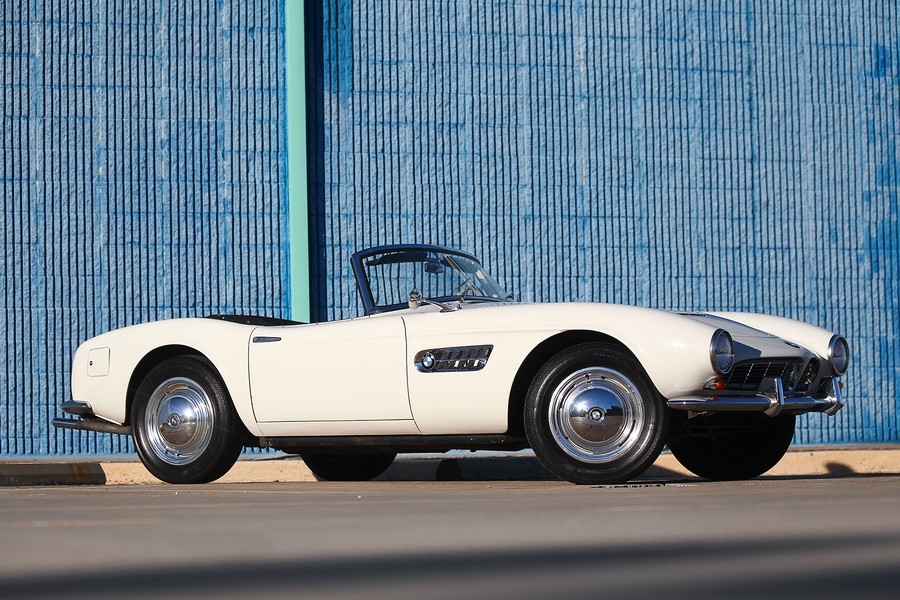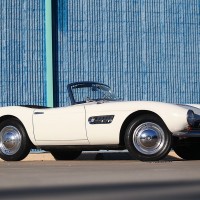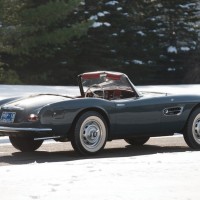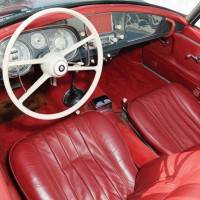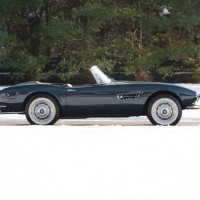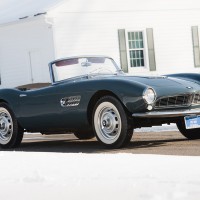BMW 507 Chassis 70134 (Gooding & Co.)
Constructed in late 1957, it is believed that this 507 was sold new to the United States through Hoffman Motors of New York. According to the research of marque experts, just 34 examples of BMW’s 507 were officially exported new to the U.S. Over the years, the 507 was a frequent participant in many BMW Vintage and Classic Car Club of America events, taking part in a variety of shows, tours, and special BMW Holidays. Most recently, the 507 made the journey from Colorado to New Mexico, where it was proudly displayed at the 2011 Santa Fe Concorso. Today, this 507 appears to have never been subject to a complete restoration and remains in strikingly original order throughout. As 507s continue to join major collections, it has become increasingly difficult to find such a desirable car for public sale, let alone an example such as this, with remarkable originality and a well-known provenance. Presented here is a matching-numbers 507 that has been the undisputed centerpiece of a highly regarded, single-marque collection for almost 30 years.BMW 507 Chassis 70156 (RM Auctions)
It is safe to say that Malcolm Pray was among the 507’s admirers when it was first offered, which was about the same time that he was getting his own start in selling German automobiles. He was further influenced by an encounter with a fellow Greenwich resident, Al Mitchell, who was an airline pilot who happened to own a 507. After an inquiry from Pray, Mitchell located this car in Pennsylvania, still with its original owner, Alan Friedland. Friedland was an enthusiastic participant in Sports Car Club of America races during this era. Surviving records indicate that Friedland drove his 507 in the Northeast Ohio Regional Races of the SCCA. The car was purchased by Mr. Pray, who became its second owner, on August 17, 1972, and he would never sell it. In the 1980s, the interior was reupholstered in red Connolly leather, new Wilton wool carpeting was installed, and the interior wood was replaced or repaired as necessary. In 1997, the 507 underwent more significant work, with all trim removed, repaired and reinstalled. In 2006, the body was stripped, minor scratches and dents were repaired, and all panels were refinished in Graphite. The Pray 507 was equipped at the factory with a Becker Mexico radio, as well as with two of the most desirable items: Rudge wheels and a removable hard top. The 507’s original 155-hp Series II engine, number 40167, was recently offered to the Pray Estate. Its authenticity to this chassis was confirmed by the 507 Registrar of the Historic BMW Club Germany, Wolfgang Niefanger, and BMW Classic. The original engine was acquired, fully rebuilt, and is now offered with the purchase of the car.SCM Analysis
Detailing
| Vehicle: | Two BMW 507 Sales at Amelia Island |
| Number Produced: | 253 |
| Original List Price: | $11,000 |
| Tune Up Cost: | $1,950 |
| Distributor Caps: | $500 |
| Chassis Number Location: | Plate on the firewall, stamping on the chassis near right front suspension pickup point |
| Engine Number Location: | Right side of the block |
| Club Info: | BMW Car Club of America |
| Website: | http://bmwcca.org |
| Investment Grade: | A |
1958 BMW 507 chassis 70134, Lot 21, sold for $1,815,000, including buyer’s premium, at Gooding & Company’s Amelia Island sale on March 7, 2014. 1958 BMW 507 chassis 70156, Lot 152, sold for $2,420,000, including buyer’s premium, at RM Auctions’ Amelia Island sale on March 8, 2014.
I wrote a profile of a 1957 BMW 507 for the February 2008 SCM (German Profile, p. 58). It was of a car sold at the RM London sale in October 2007. It sold for a healthy $893,104 (£1.00=$2.056), which at today’s exchange (£1.00=$1.681) would have been $730,152. In that piece, I wrote about how the 507 came to be at the behest of legendary importer Max Hoffman, and how his well-chosen target price of $5,000 was doubled. The 507 and sister 503 2+2 coupe and cabriolet had no association besides the blue and white roundel.
The BMW 507 was a failure when new — but it was a glorious failure, as so many great beauties in history have been. Nevertheless, the 507 has achieved blue-chip status as a collectible automobile because of its stunning looks, rarity, and driving experience — in that order. Not that there’s anything wrong with falling for a car for its loveliness — as Lorelei Lee so truthfully declared in “Gentlemen Prefer Blondes”: “Don’t you know that a man being rich is like a girl being pretty? You wouldn’t marry a girl just because she’s pretty, but my goodness, doesn’t it help?”
Appraising very similar cars
A trained professional appraiser begins a credible value opinion with an object’s attributes of value. These are the factors that make a particular object of interest more — or less — desirable to the market. They can, and usually do, include the presence of original driveline components — especially the engine — original body panels, factory-installed performance options or rare accessories, certain colors, and of course, condition and provenance.
These individual attributes are very important when comparing two very similar objects —say, two 1958 BMW 507 Series II roadsters that sold on the same weekend — and determining price differences.
The whole can indeed be greater than the sum of its parts when it comes to selling cars at auction. Impressive results from the sale of many single-owner car collections happen over and over in collector car auctions around the world. This “power of collections” is especially potent when the collection is well-curated. This can make the provenance attribute take on vastly enhanced weight in determining value.
Two similar cars, two different collections
We have two BMW 507s from two very different collections. RM Auctions featured cars from the late Malcolm Pray. He was very well known in the vintage-car world, and he showed his cars at all the top concours in the country. Pray owned his BMW 507 since 1972.
Gooding & Company didn’t identify who owned the collection of BMWs in their tent, but a quick Google search found the cars had been recently owned by a fellow well known in BMW circles. This man had also been a long-term owner of his 507, and it had been shown at many marque events and featured in several periodicals.
So let’s go through a comparison of the attributes of value of each of the cars and try to find the $605,000 difference in value between the two 507 roadsters:
They are both Series II cars, which is the more desirable model for its enhanced creature comforts and more power. No difference there.
The RM car was finished in dark gray, which was arguably more dramatic than the white of the Gooding car, but BMWs have always looked good in white. A draw there. The Gooding car was fitted with its original engine, which the RM car was not. But the RM car did come with the original, to be installed by the new owner. Here, a slight advantage to the Gooding car.
The RM car came with the very cool factory hard top and was also equipped with center-lock Rudge wheels. The mounting points for the hard top had been removed when the car was restored in the 1990s. After speaking to dealers and collectors — as well as looking at previous sale results — I estimate that $125,000 to $150,000 might be the spike for those goodies. Points for the RM car.
In terms of condition, they were, by my observation, a bit similar. The RM car was a very nicely maintained older restoration, showing some age but very presentable and drivable. The Gooding car was reported to have never been apart for restoration but simply maintained as necessary, and it had a wonderfully original, used-but-cared-for feel. It was reported to have date-code stamped wheels, and the original interior was nicely patinated. Both would be an excellent base for a no-holds-barred total restoration if that was the new owners’ plans. I count this as a slight advantage to the Gooding car.
Pray’s provenance is key
We finally come to provenance. It is certain that Malcolm Pray’s connection to the car helped push up value for the RM car. The 507 had the benefit of the halo of the Pray Collection and extensive iconography with its well-known, long-term owner.
The Gooding 507 did not have that benefit, having been presented somewhat anonymously. It also was the star of Gooding’s Amelia Island lineup of BMWs. It was the proverbial “best house in the neighborhood.” The Gooding car certainly had a “halo” role as relates to many of the other cars in that unnamed collection of BMWs, such as the 700s, 1600GT and so on.
With the notable exception of a handful of models, led by the 507 and 328, BMW has not featured significantly in the collector car consciousness. This sale at Gooding has certainly helped to elevate that awareness, and it will be interesting to see what happens when the next few BMWs come to market.
There is little doubt in my mind that the attributes of value show clearly that — putting aside possible testosterone exuberance in the bidding at RM — the collection aura of Malcolm Pray was responsible for the $450,000 differential not covered by the hard top and Rudge wheels.
It is doubtful that the new owner of the RM 507 could realize a similar differential when selling. What is not in doubt is that after many auction sales hovering at the $1m range — and the $1.65m achieved at RM / Sotheby’s in New York last year — the 507 is firmly and deeply in the upper $1m range. It’s time for us to adjust the SCM Price Guide. ♦
(Introductory descriptions courtesy of Gooding & Company and RM Auctions.)
